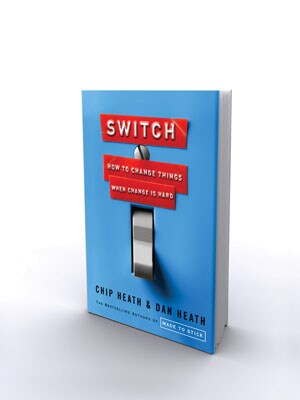
How Organizations and Communities Can Create Change
People want change to happen but worry about the consequences of disturbing the status quo. Professor Chip Heath explores paths to realizing change in Switch: How to Change Things When Change Is Hard, a book he coauthored.
Humans possess two minds — an “analytical brain” that plans for the future and an “emotional brain” that falls in love with routines and familiarity. The dichotomy helps explain why change is so hard, says a Stanford professor in a new book, Switch: How to Change Things When Change Is Hard.
“We’re all schizophrenic about change. Part of us wants to lose a few more pounds, part of us wants an Oreo,” said Chip Heath, the Thrive Foundation for Youth Professor of Organizational Behavior at the Stanford Graduate School of Business. “One side … may want a change to happen intellectually. Butanother part of us may be comfortable with the status quo and worried about whether we have what it takes to change.”
Heath wrote Switch with his brother, Dan Heath, a senior fellow at the Social Enterprise Center at Duke University. In Switch, they examine how organizations and communities can create change. Chip Heath recently previewed the book at a Stanford conference on nonprofit management, where he gave nonprofit leaders suggestions for creating change in their organizations during tough economic times.
He frequently invoked the image of an elephant and a rider to illustrate why change is so challenging. The human rider, representing the rational side of our brains, appears to be in charge of the elephant, representing the emotional side of our brains. “But, note, if there’s ever a disagreement about direction, the rider won’t win the battle. The elephant has a six-ton advantage,” said Heath.
Would-be change leaders often err by being overly intellectual, arming themselves with spreadsheets and datato make the case for change, while underplaying the role of emotion and motivation.
Heath offered several recommendations for making change easier. First, “direct the rider.” That means providing clear direction so that people start imagining how the change could work rather than getting mired in over-analysis and debate about whether change should happen or not. Second, “motivate the elephant” to go down the path by helping people feel that change is desirable and that they are capable of making the change.
He cited the grassroots efforts to revitalize rural Miner County in South Dakota, which was struggling with a decline in farming and an exodus of young people. To spruce up one town center blighted by dead tree stumps, residents organized a “stump pulling party” that built enthusiasm for community renewal. That led to a high school teacher assigning students to survey the local economy.
The students, after completing their survey, convened a citizens’ meeting to present their results. Their research had uncovered that if residents simply spent 10% more shopping at local retailers rather than driving to outlet malls in Sioux Falls, that tax revenues would go up by $7.6 million, creating funds to reinvest in the community. This simple target motivated residents to change their behavior because it was such a clear goal, and seemed so approachable. The following year, tax revenue went up by $15 million, surpassing expectations. Eventually, some businesses ventured into the business of repairing wind turbines — a good match for a community where people had grown up around farm equipment. Today, there’s a thriving “green tech” wind turbine repair industry in the county, and the population is growing again.
Heath called the Miner County experience a “remarkable story of economic transformation.” County residents came up with a clear and simple direction for the rider — do 10% more shopping locally. They also motivated the elephant by creating a strong feeling of community, exemplified by the stump-pulling party and the student-sparked change.
Another way to create change is to “find the bright spots.” Heath described the experience of an American activist sent to Vietnam years ago to help poor rice farmers alleviate malnutrition. Instead of relying on “stacks and stacks of academic literature” about malnutrition in developing countries, the activist approached mothers in one village and asked them to identify the children in their village who were bigger and healthier. The mothers of these “bright spot” kids were doing something simple: feeding their children four smaller meals a day instead of two larger ones, and mixing sweet potato greens and brine shrimp into rice, thus adding vitamins and proteins. Villagers then organized cooking get-togethers to teach families this simple but effective technique. Six months later, 65% of the children were better nourished, and the village’s approach eventually became a model for other villages.
Yet another strategy for change is to train people to adopt a “growth mindset” in which challenges or failures are treated as opportunities for improving and acquiring skills. That contrasts with a “fixed mindset” in which ability is viewed as basic, unchangeable quantity. Heath cited the work of Carol Dweck, Stanford psychology professor, with middle school math students who were trained on the growth mindset. When taught that the “brain is a muscle” that can grow over time, the students reversed a school-wide decline in their math scores. “How would we differ in our own willingness to tackle changes if we started believing ‘the brain is a muscle’?” asked Heath.
Heath spoke at the Stanford Nonprofit Management Institute sponsored by the Stanford Social Innovation Review and the Association of Fundraising Professionals. The Heath brothers’ new book follows the 2007 publication of their best-selling book, Made to Stick: Why Some Ideas Survive and Others Die, which was retired from the Business Week bestseller list after two years. Their book has been translated into 27 languages including Arabic, Romanian, and Thai.
This piece originally appeared in Stanford Business Insights from Stanford Graduate School of Business. To receive business ideas and insights from Stanford GSB click here: (To sign up: https://www.gsb.stanford.edu/insights/about/emails)





